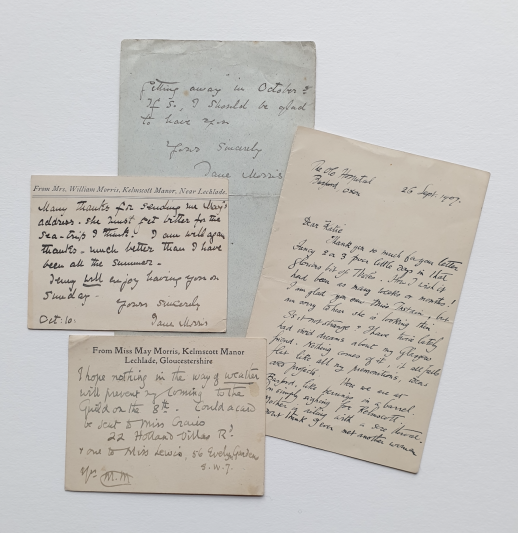Dr Kathy Haslam, Curator, writes: The Society of Antiquaries of London is most grateful to FNL for its generous grant towards this acquisition for Kelmscott Manor. The Manor is renowned as the country home of Victorian polymath William Morris (1834 – 1896) and his family. Their connection with the estate extended over a 67-year period from 1871, during which Morris’s widow Jane purchased it (1913) and their younger daughter May Morris made provision for its future.
This miscellany of papers originates from the private archive of Arthur Halcrow Verstage, architect, photographer and founding member of the Kelmscott Fellowship, for whom the Manor had a particular resonance. The recipient of several of the letters is Kate Whitaker, a longstanding friend to whom May Morris writes candidly about her mother’s longstanding preoccupation with her health, the subject of much theorising by biographers over the years. Both were at the time staying at The Old Hospital in Burford, the house 10 miles distant from Kelmscott rented some years earlier by Jane Morris in order to be within reach of the Manor yet away from the risk of flooding and the inhospitable winter conditions there. This is a little-documented aspect of her later life. Another letter concerns a legacy from May Morris to Kate herself. And during the months following May’s death it was Kate, as we now know from further correspondence in the collection, who gave her assistance to auctioneers Hobbs & Chambers by identifying objects at the Manor and contributing to the preparation of the auction catalogue of the property’s contents. Poignantly, she was at that date living in the very house in Hammersmith that May had vacated to move permanently to the Manor in 1923. As the Hobbs & Chambers business archive does not survive, this correspondence is particularly noteworthy in terms of documenting the auction process.
Playwright and polemicist George Bernard Shaw (1856 – 1950) also features, both as a young man, in the guise of a portrait photograph inscribed to fellow socialist ‘Comrade’ May during the days of their relatively brief and inconclusive courtship (1886), and in another photograph taken almost half a century later when in 1934 he attended the opening of the Morris Memorial Hall, a substantial village asset instigated by May Morris and only built due to her determined and protracted fundraising. The collection also contains two other documents relating to its opening ceremony. The Memorial Hall was the final element of the distinctive architectural heritage in Kelmscott for which Jane and May Morris were responsible, useful buildings designed by leading Arts and Crafts architects intended to benefit the village from both a social and cultural perspective whilst collectively memorialising William Morris.
These papers are an extremely welcome addition to Kelmscott Manor’s archive and are available for consultation by appointment
